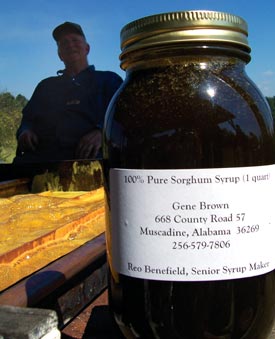Stickin’ Together

Rich, sorghum syrup does a great
job of holding a hot, buttered
biscuit together, but for a group
of Cleburne County brothers, the syrup
has been the bond that holds a family
together.The Brown brothers, Winford, Gene,
Silas and Ralph, grew up watching syrup
being made on their family’s farm in
northeast Alabama when a traveling
syrup mill would come to their property.
Years later, Gene’s interest in syrup making
was rekindled when his father-inlaw,
the late Gaines Smith, would
recount his boyhood syrup-making experiences.”When Mr. Smith’s health began to
fail, I planted a small patch of sorghum
that turned out only a pickup load, and I
had it cooked at Reo Benefield’s place
thinking this would cheer up Mr. Smith
and bring back fond memories,” says
Gene. “That pickup load only produced
a few gallons of syrup, but it did wonders
for my father-in-law’s spirits.”The second year, Gene built a cooker
and furnace on his farm in Muscadine,
Ala., and produced 14 1/2 gallons of
syrup. That success–coupled with the
joy he felt in preserving part of his family’s
heritage–prompted Gene to get his
brothers involved, and for the past seven
years, the Browns, along with Benefield
and Harold Davis, have produced 100
gallons of syrup a year.Starting in late September when the
seed heads of the sorghum stalks turn a
rich, golden color, the brothers meet at
Gene’s place for the annual sorghum
cooking. Before the furnace gets fired up,
however, the Browns sample the quality
of the stalks by running a few canes
through the juicer before they harvest
the crop.”We taste the juice coming out of the
juicer,” says Winford, who serves on the
Cleburne County Farmers Federation
Board of Directors. “The sweeter it tastes,
the more syrup the juice will yield.”The cane is gathered by cutting the
stalks with machetes or sometimes a
corn binder, which cuts and ties bundles
of stalks together. Silas and Ralph then
take over the job of stripping the leaves
and cutting the seed heads off the stalks
which prepares the cane for juicing.Gene uses a Chattanooga 13 juicer which was formerly powered by a mule
walking in revolutions around the mill
pulling a long, boom pole. The Brown
brothers have modified a riding lawn
mower by tying the handles in a stationary
position to serve the same purpose
as a mule.Davis’ job is operating the juicer–a
contraption with two vertical rollers
that squeeze the juice out of the canes.
The juice is strained into 55-gallon
drums and then flows to the cooking
pan through underground piping.Winford’s job is keeping the furnace
fed with dry, pine wood. “Pine burns
quicker than hardwood, and that makes
it easier to adjust the heat,” says
Winford. “It uses the same principle that
was used for cooking with stoves before
we had gas and electric ovens.”Benefield, who the
brothers call the “master
cooker,” is in charge of
keeping the syrup boiling
at a steady, even pace.
“When the syrup is at the
final stage of cooking, it
is at a temperature of
about 240 degrees,” says
Benefield. “The syrup
must be kept below 254
degrees Fahrenheit or it
will scorch.”The syrup is formed
by an evaporation process
when the juice enters the
pan. As the wood fire in
the furnace heats the pan,
the juice travels through a maze of slots,
and green foam forms at the top. These
skimmings are dipped off into a bucket
and discarded.”The syrup is already in the juice we
take from the cane,” says Winford. “The
cooking process just takes the water and
skimmings out, leaving the concentrated
syrup.”It takes around seven gallons of juice
to make one gallon of syrup. “On average,
once the juice hits the pan, it takes
an hour and 20 minutes to come out of
the pan as syrup,” says Winford.When the syrup has finished cooking,
it is strained through cheese cloth and
held in a reservoir. The container has a
faucet that allows individual jars to be
filled.Gene plants the sorghum
at different time intervals so
the entire crop doesn’t
mature at the same time.
“By staggering the planting
dates, we have a chance to
gather the cane and make
syrup over a longer period of
time,” says Gene. “This
keeps us from having to prepare
the whole crop at once.”The brothers agree that
the stages leading up to the
cooking of the syrup are the
most labor intensive.”There’s more work in
cutting, stripping and
removing the seed heads
than cooking,” says Winford.
“But I love the smell of
syrup as it’s
being cooked,
the comradeship
with my
brothers and
the closeness
we get each
year in
September.”The majority of the
syrup is sold by word of
mouth. The remaining
jars are sold through the
local feed mill and a
farmer’s market in
Atlanta, Ga. “We’re kinda
like the famous ice cream
company,” says Gene.
“We eat all we can and sell the rest.”The brothers joked with Davis about
his experience selling sorghum. A member
of Davis’ church purchased a jar of
syrup, and Davis told her he would give
her the jar after church the following
Sunday. When he opened his trunk after
church, other parishioners saw the jars
of syrup in a box and bought all he had.”I began to get nervous,” said Davis.
“I remembered what Jesus did to the
money changers in the temple, so I
decided not to bring any more syrup to
church with me.”For more information about the Brown
brothers syrup making, call Gene Brown
at (256) 579-7806 or Winford Brown at
(256) 579-2262.
